Posts Tagged: biodiversity
Extreme weather accelerates nitrate pollution in groundwater
Extreme weather spurred by climate change, including droughts and heavy rains, may increase the risk of nitrates from fertilizers ending up in groundwater, according to a recent study from researchers at the University of California, Davis. The study found heavy rains after a drought caused nitrates to seep 33 feet under farm fields in as little as 10 days. The study was published in Water Resources Research.
“The conventional wisdom was that it could take several weeks to years for nitrates to move from the crop root zones to reach groundwater,” said corresponding author Isaya Kisekka, a professor in the Departments of Land, Air and Water Resources and Biological and Agricultural Engineering. “We found these extreme events, such as California's atmospheric rivers, are going to move nitrate more quickly.”
In this study, different methods were used to measure how much nitrate, a component of nitrogen fertilizer, was seeping down through the soil in a tomato and cucumber crop near Esparto, California. Scientists conducted their research from 2021 until 2023 when California was experiencing periods of drought followed by atmospheric rivers. They measured nitrate during both the growing seasons and the rainy seasons.
Drought can leave more nitrogen in soil
Previous studies have shown about 40% of nitrogen fertilizer used for vegetables isn't absorbed by the plants but remains in the soil. During droughts, crops don't use nitrogen efficiently, leading to excess nitrogen in the soil. This study found that if a drought is then followed by heavy rainfall, that sudden burst of water causes nitrate to seep in groundwater more quickly. The nitrate concentration in the shallow groundwater exceeded the U.S. Environmental Protection Agency maximum contaminant level of 10 milligrams per liter for drinking water.
“In California, we often say we swing between droughts and floods,” said Kisekka. “These extreme events that come with climate change are going to make the risk of these chemicals ending up in our drinking water much more severe.”
Groundwater is the primary source of drinking water for most of California's Central Valley. In some regions, such as the Tulare Lake Basin, nearly one-third of drinking and irrigation wells exceed the EPA's safe nitrate level. High nitrate levels in drinking water can increase health risks, especially for young children. It may also increase the risk of colorectal cancer.
Need for real-time soil nitrate monitoring
Central Valley farmers are required to report to the Regional Water Board how much nitrogen they applied to their field and how much was removed as part of the crop's yield. The study compared different ways of monitoring when nitrate from fertilizers seep into groundwater. Kisekka said the results highlight the need for affordable, real-time soil nitrate monitoring tools to help farmers manage fertilizer use efficiently.
By using conservation practices that limit leftover nitrates in the crop's root zone after harvest, farmers can help reduce nitrate contamination in groundwater.
This study's data will also help improve a model called SWAT, which is used to track nitrate seepage into groundwater across California's Central Valley. This effort is part of the Central Valley Water Board's program to regulate irrigated farmlands.
Other UC Davis authors include Iael Raij Hoffman, Thomas Harter and Helen Dahlke.
The study was supported by the USDA Natural Resource Conservation Service through its Conservation Effects Assessment Project. The national project is designed to assess the effectiveness of conservation practices across different watersheds. The study also had support from the USDA National Institute of Food and Agriculture.
Lawn-pocalypse! Surviving Drought
Ah, summer! The season of sunburns, pool parties, and… lawn droughts. If your once lush, green carpet now looks like a crunchy brown doormat, you're not alone. Let's dive into why your yard is staging a dramatic death scene and what you can do to...

Bermuda grass and weeds overtaking drought stressed turf grass.
USC Biologist on 'Trends of Bee Biodiversity in North America'
Bee biodiversity? It promises to be an interesting seminar. Assistant professor Laura "Melissa" Guzman of the University of Southern California (USC) will discuss "Using Occupancy Models to Infer Trends of Bee Biodiversity in North...
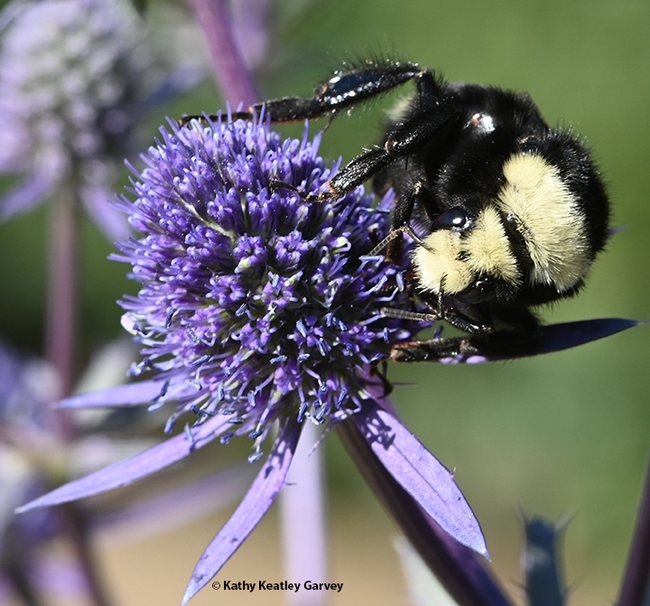
A yellow-faced bumble bee, Bombus vosnesenskii, sipping nectar from an Amethyst Sea Holly, Eryngium amethystinum, in Sonoma. (Photo by Kathy Keatley Garvey)
Invasive plant time bombs: A hidden ecological threat
Non-native species can wait decades or centuries before spreading Invasive plants can stay dormant for decades or even centuries after they have been introduced into an environment before rapidly expanding and wreaking ecological havoc, according to a...
At the Bohart: Life Is Better With Bugs
They came. They saw. They held out their hands. Hands? Yes, to hold Madagascar hissing cockroaches and stick insects (walking sticks). The Bohart Museum of Entomology greeted some 1400 visitors during the 13th annual UC Davis Biodiversity...
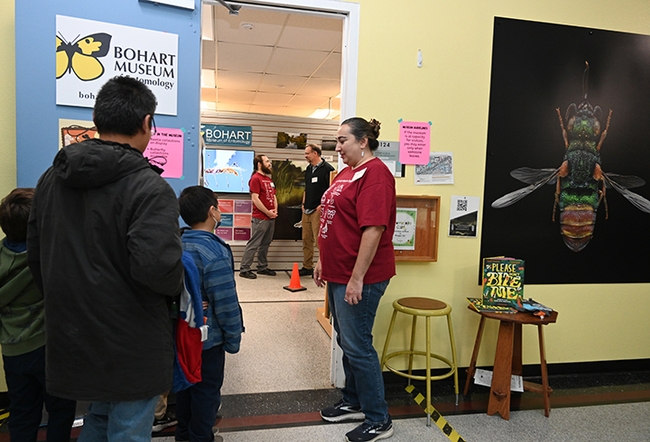
Bohart associate and entomologist, Nazzy Pakpour, PhD, author of "Please Don't Bite Me: Insects that Buzz, Bite and Sting," greets guests at the Bohart Museum. In back are Bohart director Jason Bond (right) conversing with Brennen Dyer, collections manager. (Photo by Kathy Keatley Garvey)
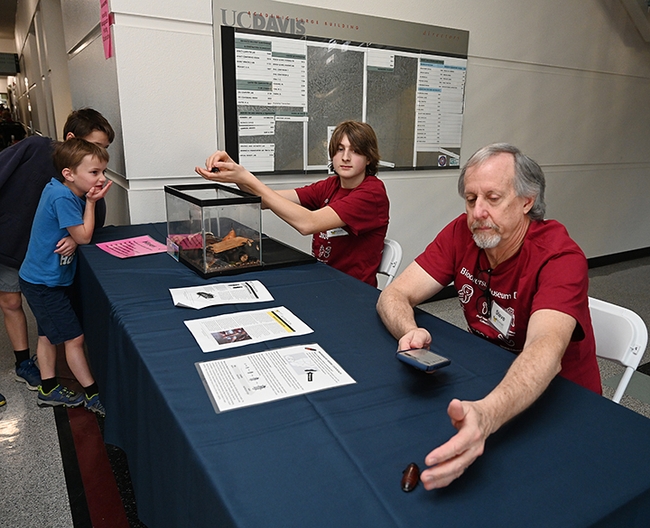
Steve Heydon (foreground), retired Bohart Museum collections manager, with a Madagascar hissing cockroach. In back is intern Andrew Logan. (Photo by Kathy Keatley Garvey)
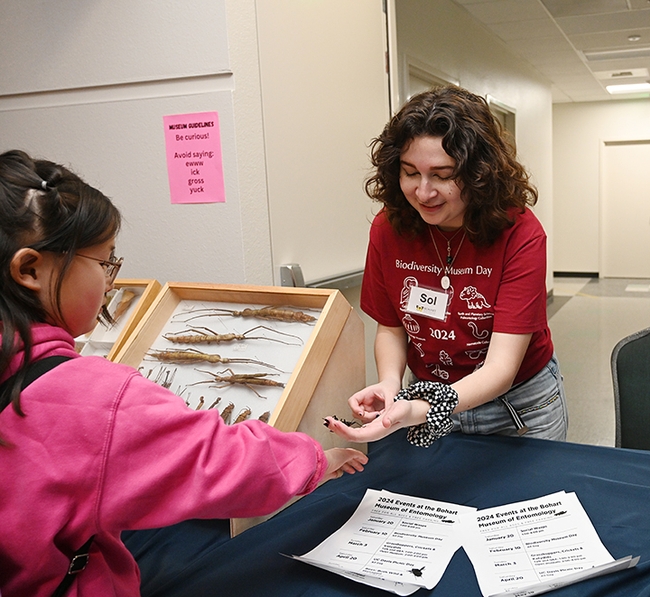
UC Davis student and Bohart associate Sol Wantz, president of the UC Davis Entomology Club, shares a stick insect. (Photo by Kathy Keatley Garvey)
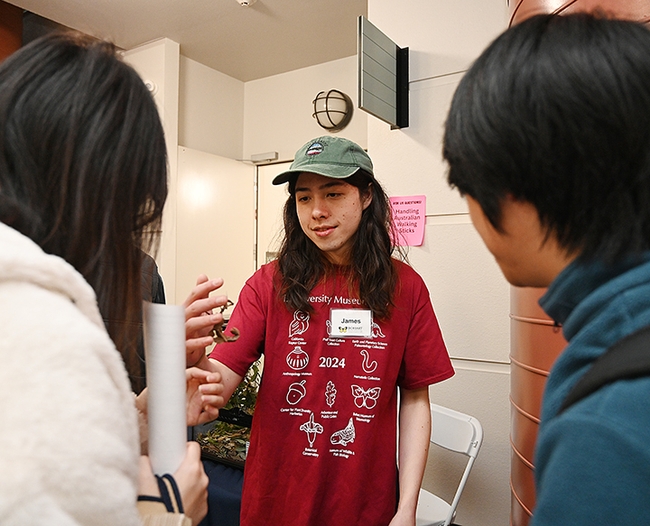
"Want to hold a stick insect?" asks Bohart associate James Heydon. (Photo by Kathy Keatley Garvey)
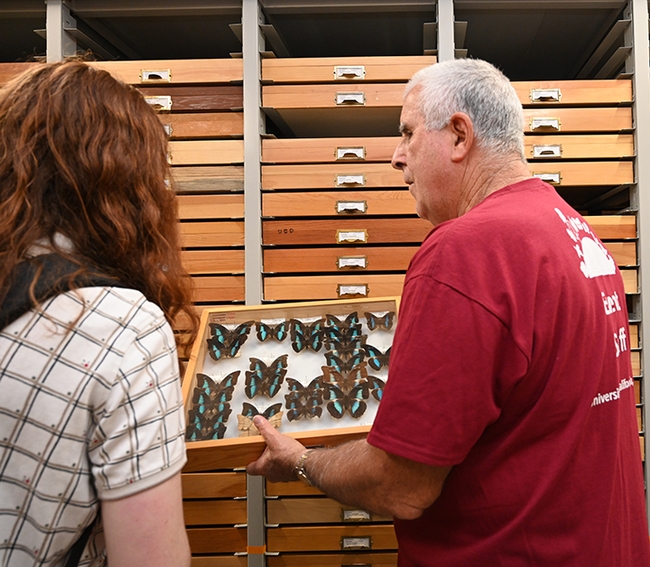
Entomologist Jeff Smith, curator of the Bohart Museum's lepidoptera collection, shows butterflies from the genus Archaeoprepona. They are tropical, ranging from south Mexico to southern South America. "They are very strong fliers but usually come to rotting fruit or dead animal baits," he says. (Photo by Kathy Keatley Garvey)
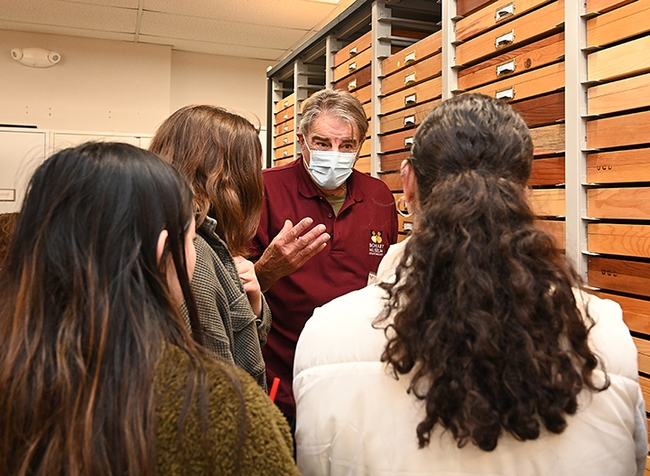
Bohart associate Greg Kareofelas answers questions about butterflies. (Photo by Kathy Keatley Garvey)

